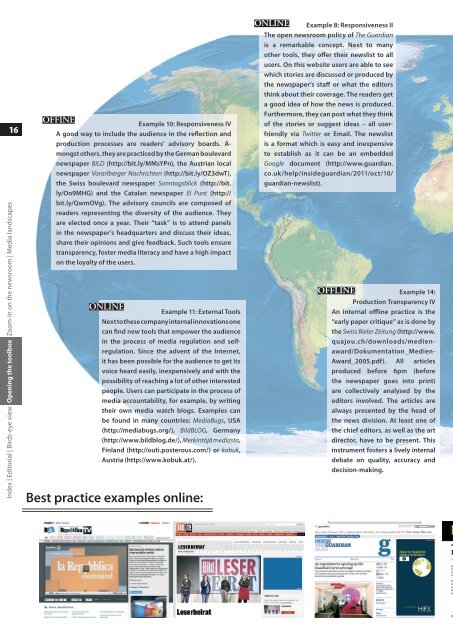MediaAcT
How fragile is media credibility? Accountability and transparency in journalism: research, debates, perspectives Final Research Report | Media Accountability and Transparency in Europe
How fragile is media credibility? Accountability and transparency in journalism: research, debates, perspectives
Final Research Report | Media Accountability and Transparency in Europe
You also want an ePaper? Increase the reach of your titles
YUMPU automatically turns print PDFs into web optimized ePapers that Google loves.
1<br />
Index | Editorial | Birds-eye view | Opening the toolbox toolbox|<br />
Zoom-in on the newsroom | Media landscapes<br />
OFFine<br />
Example 10: Responsiveness IV<br />
A good way to include the audience in the reflection and<br />
production processes are readers’ advisory boards. Amongst<br />
others, they are practiced by the German boulevard<br />
newspaper BILD (http://bit.ly/MMsYPn), the Austrian local<br />
newspaper Vorarlberger Nachrichten (http://bit.ly/OZ3dwT),<br />
the Swiss boulevard newspaper Sonntagsblick (http://bit.<br />
ly/Oo9MHG) and the Catalan newspaper El Punt (http://<br />
bit.ly/QwmOVg). The advisory councils are composed of<br />
readers representing the diversity of the audience. They<br />
are elected once a year. Their “task” is to attend panels<br />
in the newspaper’s headquarters and discuss their ideas,<br />
share their opinions and give feedback. Such tools ensure<br />
transparency, foster media literacy and have a high impact<br />
on the loyalty of the users.<br />
Online<br />
Example 11: External Tools<br />
Next to these company internal innovations one<br />
can find new tools that empower the audience<br />
in the process of media regulation and selfregulation.<br />
Since the advent of the Internet,<br />
it has been possible for the audience to get its<br />
voice heard easily, inexpensively and with the<br />
possibility of reaching a lot of other interested<br />
people. Users can participate in the process of<br />
media accountability, for example, by writing<br />
their own media watch blogs. Examples can<br />
be found in many countries: MediaBugs, USA<br />
(http://mediabugs.org/), BildBLOG, Germany<br />
(http://www.bildblog.de/), Merkintöjä mediasta,<br />
Finland (http://outi.posterous.com/) or kobuk,<br />
Austria (http://www.kobuk.at/).<br />
Best practice examples online:<br />
Online<br />
Example 8: Responsiveness II<br />
The open newsroom policy of The Guardian<br />
is a remarkable concept. Next to many<br />
other tools, they offer their newslist to all<br />
users. On this website users are able to see<br />
which stories are discussed or produced by<br />
the newspaper’s staff or what the editors<br />
think about their coverage. The readers get<br />
a good idea of how the news is produced.<br />
Furthermore, they can post what they think<br />
of the stories or suggest ideas – all userfriendly<br />
via Twitter or Email. The newslist<br />
is a format which is easy and inexpensive<br />
to establish as it can be an embedded<br />
Google document (http://www.guardian.<br />
co.uk/help/insideguardian/2011/oct/10/<br />
guardian-newslist).<br />
OFFline<br />
Example 14:<br />
Production Transparency IV<br />
An internal offline practice is the<br />
“early paper critique” as is done by<br />
the Swiss Bieler Zeitung (http://www.<br />
quajou.ch/downloads/medienaward/Dokumentation_Medien-<br />
Award_2005.pdf). All articles<br />
produced before 6pm (before<br />
the newspaper goes into print)<br />
are collectively analysed by the<br />
editors involved. The articles are<br />
always presented by the head of<br />
the news division. At least one of<br />
the chief editors, as well as the art<br />
director, have to be present. This<br />
instrument fosters a lively internal<br />
debate on quality, accuracy and<br />
decision-making.


